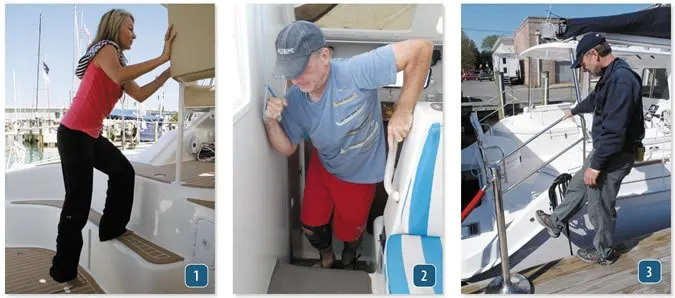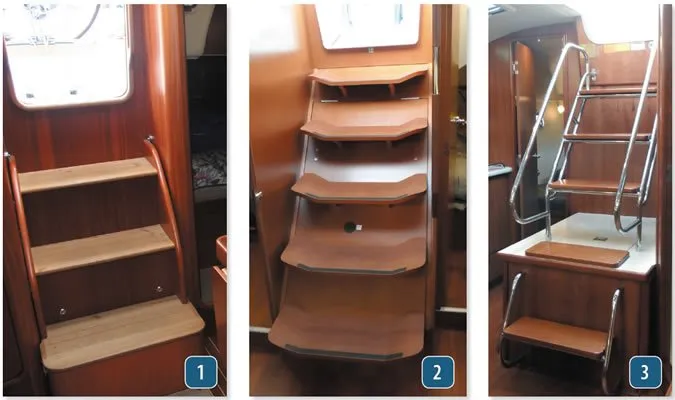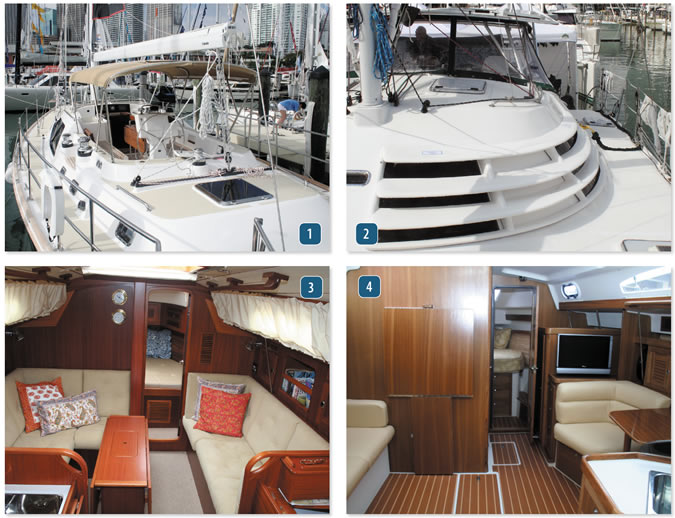Boat shows present a wonderful opportunity to not only explore boats well beyond your price range, but also to observe how designers answer the many compromises that each boat design requires. Some designs succeed, and some don’t-and often the weak spot is a simple failure to understand the customer.
At last falls U.S. Sailboat Show in Annapolis, Md., PS contributor Drew Frye was sitting in the cockpit of a lovely 50-foot catamaran with eight other mature sailors-all serious lookers whose legs were also throbbing from a long day of walking the miles of exhibit tents and touring many boats. These were sailors who had worked long years to accumulate the scratch to write a check for the $500,000-$1,000,000 that such a boat would cost. All were over 50 years old, most considerably older.

As Fryes eyes wandered around the boat, he saw many potential problems for him and his wife, and nearly all of them were steps. As spacious as this boat was, all of the steps were 16 to 19 inches high-more than double the seven-inch rise in an average stair step. These high steps would be particularly troublesome for his wife, who has a knee replacement and an arthritic ankle. And for the crowd of mostly older visitors who came aboard the catamaran, these steps were clearly difficult to navigate-even at the dock. One can only imagine the sort of obstacle they would present at sea.
Curious, Frye asked for a show of hands among the sailors gathered. How many of you have had either a joint replacement, or have a spouse or parent with a joint replacement or serious joint surgery? Six of the eight hands shot up, and the others said they anticipated surgery in the future.
Frye turned to the catamaran sales people-athletic 30-somethings-and asked, If this is your real demographic-its a long road to save this much money-then why isn’t the boat designed with our knees in mind? Keep in mind, most of us are not buying a boat for today, but for where our bodies will be in five to 10 years.
The salesmen responded with open mouths and no useful answers. The rest of the day, Frye posed the same question to salesmen and designers throughout the boat show, and got variations on the same answer: The reality of boat design requires cramming as much into the available space as possible, and thus a certain athleticism may be required of the crew. Frye accepted that reasoning with regards to pure performance boats-his former boat, a Stiletto 27, had some big steps (even those he modified to suit his familys needs). However, while this kind of compromise is fine for flat-out racers, it makes little sense for a cruising boat. Some designers have listened, and they create step sizes that are reasonable. But they remain the minority.
So what can we do? Between his wifes knee replacement and his own joint problems (he shattered his knee in college), Frye has had to make modifications to several of his boats, most recently a PDQ 32 catamaran. After looking at his own succesful solutions and making an informal survey of the ergonomics aboard boats at the most recent boat shows, he compiled the following report.

Adapting Existing Boats
Before running out to buy a new boat-most older sailors are happy with the boat they have-we should look at little modifications that can make big differences aboard the boats we have. Here are some modifications Frye and others have used to improve onboard ergonomics.
Runt steps: Many helm stations aboard big cats and some monohulls seem to be designed for 7-foot-tall sailors. Men of average height, women, and young sailors generally find their feet swinging comically in the air when they sit at the helm of one of these boats. This gives no leverage for working the wheel unless they sit on the very edge of the bench.
On catamarans, a runt box is a simple solution. The low-profile stool sits at the helm; it has rounded corners that cannot flip, slide, or snag ropes; and it has storage space for cockpit clutter in the hollow. It can be used permanently, or temporarily to check fit until a permanent step can be designed and installed. One of the boats Frye looked at, the very comfortable Antares 44 catamaran, comes with a runt box at the helm that can be customized to the height of the boat owner.
A well-made runt box can also be of assistance when you are getting in and out of the cockpit on a big catamaran. This is often a matter of stepping up onto the seats, and then up onto the deck, two 16- to 18-inch steps in a row. This can be double-trouble for damaged knees and for anyone carrying a heavy load. Fold-down steps can also work for this problem.
Another place where a portable step comes in handy is down below. Because of the way hulls curve, bunks are often set up high to take full advantage of the boats beam. In the case of his own boat, Frye found a custom-fitted sea chest to be a perfect solution, providing just the right step height, a convenient place to store shoes, and a nautical touch.
Hand loops and handholds: Sometimes steps cannot be made shorter, and an extra handrail would get in the way. For these places on board his boat, Frye has crafted some simple grab loops made from 1-inch webbing. He has found these to be better than grabrails because they are high and grip the wrist. They also provide considerable security when descending the stairs in an active seaway. They take no space, cost almost nothing to install, and can easily be stowed, although you could leave them rigged all the time. Frye used sail ties to create his loops during the boats first trip seven years ago. They have remained in use, unchanged, and since then, he has added a few more.
Stainless handholds are often too small in diameter for optimum grip. Wrapped tightly with line, they are more comfortable and secure. Fancy coach whipping is not required, but it does need to be applied very tightly. To make it really tight, don a pair of grippy sailing or gardening gloves, and give the wrapping a couple of hard twists.

Mast steps and companionway ladders: Frye is an enthusiastic climber; he spends summers on rock and winters on vertical ice. Yet, he finds the setups for mast steps and companionway ladders to be a challenge-and has since he was much younger. The norm for these installations seems to be around 15 inches between steps. Frye knew that rock-climbing etriers (tiny webbing ladders used when climbing big walls) are based on 10-inch steps. Why are sailors expected to climb steps so much higher than those designed for super-fit rock climbers?
According to the U.S. Occupational and Safety Health Administration (OSHA), ladder rungs should be 12 inches apart. Clearly when installing mast steps, you want to minimize weight aloft and reduce windage, but you also need to be realistic with the spacing. Companionway steps are also a common challenge. The companionway ladders on many of the boats Frye looked at were no better than his own, which has steps placed 15 inches apart.
Swim ladders also should have reasonable spacing, with at least four steps below the water. The steps should be proper, flat, deep steps (at least 2 inches deep) rather than tubes and railing extensions. A fit sailor can board with a lesser ladder, but when tired or boarding in bumpy conditions, a proper swim ladder will always be appreciated.
Lifeline gates: Stepping over a lifeline to take lines ashore can be treacherous, and stepping over them to board is just silly. Although it is less expensive to keep the lifeline circuit intact, adding additional gates fore, aft, or midships can make a big difference when boarding. One issue to be aware of is that if the stanchions at gates are not braced, you run the risk of creating too much slack in the lifeline when the gate is open. Boarding crew might reach out for the slack lifeline, only to feel it give under their weight. Frye, who added a gate near the bow for taking lines ashore, found that even though he could not brace the gate stanchion, he could lash the upper lifeline down to the stanchion with whipping twine to help keep the stays taught.

New Boats
When checking out a new boat, your eye is drawn to a graceful sheer, efficient running rigging, and beautiful interiors, but often, not much thought is given to moving around easily. As you move around the boat, imagine yourself dead tired and sore, the decks wet and heaving. What features really matter?
Boarding: Have you noticed that many boats provide boarding platforms at the boat show, even though there will be none in the real world? Wouldnt you find that strange if you were buying a car or a house? Some boats offer easy boarding from a floating dock though opening transoms, but will you want to open the transom every time you board guests? Will you back in that close to the dock? Will stern lines cross right where the transom door will drop?
Then there is the matter of tides at fixed docks. Can you step, not climb, aboard as the boat moves through a 5-foot range? Yes, you can carry portable boarding steps (see Search for Safe Boarding Boost, this issue) on board, but they have to be stored and are not always the most stable climbing platforms-and perhaps none of the crew is spry enough to be in charge of placement and retrieval.
A boarding plank? These have to be well designed and can be difficult to stow (see The Art of the Passarelle, this issue).
Sugar-scoop transoms help if the sides are low, but often, high sides are sculpted for aesthetic reasons; unfortunately, this adds nothing to function and often ruins the easy side-access that sugar-scoop transoms can afford at any state of tide.
Weve also seen perfectly accessible transoms ruined by a fixed railing in the wrong place. Some boats mold steps into the topsides, but most are too shallow to be used by a man with his arms full.
Fryes solution? He bought a boat with sugar-scoop transoms that are easily accessed from the side, so one of the steps is always at the correct height at any state of tide. He devised a small tackle to pull the boat tight to the dock (it is only in place during active boarding). If the dock is slippery, he places either a high-grip mat or a towel, which sometimes grabs the dock better, on the edge of the dock.
Companionway steps: This is an area of common disagreement. People with knee problems often prefer shallower, angled companionway steps, more like a steep staircase, while others believe a steeper ladder is better in a seaway. Additionally, ladders can present a problem when loading supplies on a big boat. The ladders are not safe to descend facing outward, so, on a big boat where the cockpit is not within easy reach of someone standing on the cabin sole, supplies must be passed through the companionway to a partner. Stairs and ladders each have their pros and cons; the important thing is to consider which best meets your and your crews needs, especially while underway in rough conditions, or while loading supplies.
On deck: Can you move everywhere, above and below decks, without letting go of a handhold? Is the handhold a secure, round shape three-quarters to 1-inches in diameter? Will it be slippery when wet? Stainless is more secure when wrapped with leather or line. Be realistic about your hand strength. Is there a good place to run jacklines on deck, free of deck control lines? Are dedicated anchors provided, or can they be easily added? Shouldnt jacklines be incorporated in the basic boat design, like seat belts?
Dinghy boarding: Unless every stop will be at a marina, the mobility-
challenged sailor will find themselves isolated on the boat while the group runs off to play unless there is easy dinghy boarding. Most boats provide no safe facility for the less agile sailor to board a dinghy. Can you imagine a car or home manufacturer expecting you to use a portable ladder every time you entered or exited?
A portable, folding ladder will serve in a pinch, but ideally, a cruising boat should have a fixed swim ladder and solid boarding steps. For those with more significant mobility issues, a proper boarding platform is the best solution. There should be a way to tightly secure the dinghy to the platform and a solid handhold between the dinghy and the platform. Davits and the tackle hanging from them can serve well.
Swim ladders: Swim ladders should always have at least four steps with full treads. Three steps just don’t work for old knees, and tubing is tough on the feet. There should also be handgrips as they come up.
Are these major design challenges? We don’t think so. Some designers get it, and build very accessible boats. Others live in an alternate reality, expecting the buyers to bend to what they are presented, blinded by appearance and overlooking function. Perhaps, if we speak up, more builders will listen.

1. A fixed, high railing on this center-cockpit boat provides security and easy handholds at sea. Notice the cut-away step to get into the high cockpit. The railing can help ease this transition when leaving the cockpit to go forward or aft.
2. Rigid louvers built around saloon windows on this catamaran serve two purposes: They cut down on heat below, and they double as easy steps to get up to the mast, which unfortunately does not have enough flat area for a proper standing workstation.
3. A fixed, centerline dining table and overhead handholds make this boat’s main saloon safe to traverse, even in a seaway.
4. The more open “dance floor” on this cruiser gives crew few places to brace themselves or hold on when moving forward or aft.

































re: Tall-step Syndrome
… and other insults to the aging sailor.
would have been interesting to learn the height of the author…. soooo many boats are in fact designed for the short to ultra short , if I hear one more NavArch or broker describe 6’3″ is Cathedral headroom I’ll throttle them. I am 6’5″. The author looks like a typical short man with issues.
Bet you’re fun at parties.
Ergonomics are a complicated issue, with problems for the particularly large or small only being a part. As the article implies, design for the intended users vs. for marketability at the boat show dock.
I can’t help pointing out some oddities in the pictures accompanying the articles. In the set of four under the heading, “50-foot Catamaran Details,” the first and third are clearly a monohull. And, as a former owner of own, I’m pretty sure the second picture is a 42-foot Manta Catamaran. The louvers described as doubling up as steps actually were not engineered to be used as steps. In fact, based on my recollection, I’m pretty sure that the fuzzy rectangle visible in the picture on the left top of the uppermost louver is a sign which reads, “DO NOT STEP HERE.”
Another ergonomic quirk of the Manta was that the companionway door sill was something like 6-8 inches above the cockpit floor but an unexpected 12-14 inch drop on the other side to the salon floor. Just enough to throw you off. Courtesy of the location of the fuel tank.